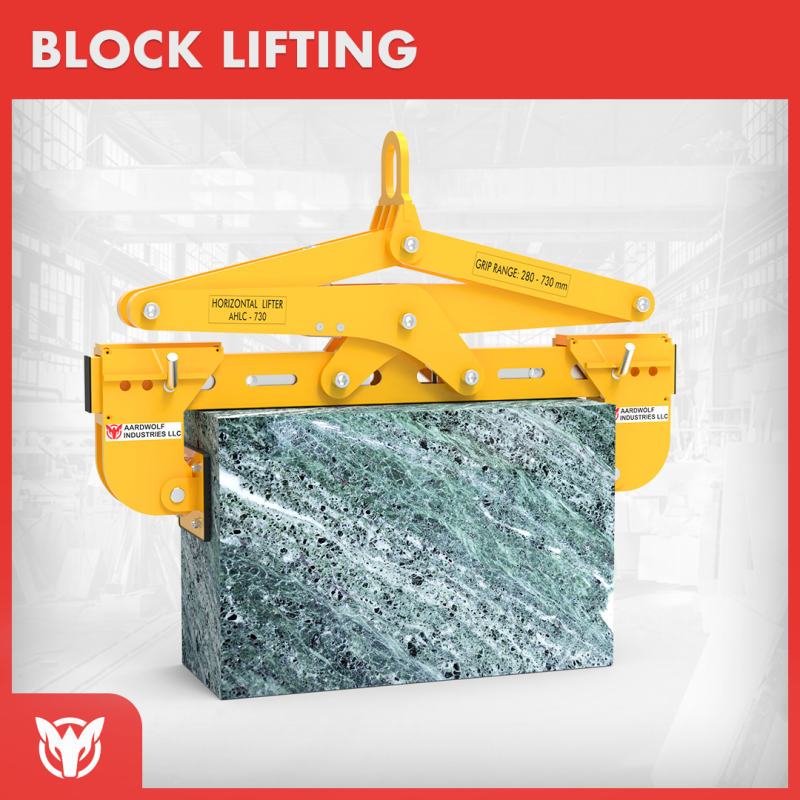



Handling heavy stone blocks and slabs is a crucial aspect of construction, stone processing, and industrial lifting. Traditional lifting methods—such as manual handling, chains, or straps—often lead to workplace injuries, inefficiencies, and material damage.
With the introduction of block lifting clamps, businesses can lift, transport, and position stone blocks with greater precision and safety. Whether used for block lifts or large slab lifting, these equipment streamline operations and protect both workers and materials.
In this article, we’ll explore:
✔ Understanding block lifting clamps and their functions
✔ How block lifting clamps improve efficiency in stone processing
✔ Best practices for lifting heavy stone blocks
✔ The long-term cost benefits of using block clamps
A block lifting clamp is a specialized material-handling device designed to grip, lift, and transport stone blocks, slabs, and concrete elements using friction, weight distribution, and gravity-assisted locking mechanisms.
A gravity-powered locking mechanism ensures the clamp automatically grips the block when lifted and releases it when set down, while high-friction rubber pads provide a firm hold and protect delicate stone surfaces from damage. The adjustable jaw opening accommodates different block sizes, enhancing versatility.
Block clamps are compatible with cranes, forklifts, and horizontal lifting clamps, allowing efficient material movement in stone processing plants and construction sites. By eliminating the need for manual securing methods, block clamps simplify lifting, making it safer, faster, and more controlled.
Traditional block lifting methods require multiple workers to secure, lift, and transport materials. A block clamp allows a single operator to handle block lifts, significantly reducing labor dependency while improving workflow. Automatic engagement and release mechanisms eliminate the need for manual adjustments, speeding up lifting cycles and minimizing downtime.
Unlike chains and slings, which create pressure points that can weaken stone slabs, block clamps distribute force evenly across the surface, preventing cracks, scratches, and chipping. Non-abrasive gripping pads protect delicate stone surfaces, ensuring safe lifting and reducing material waste.
A block clamp can lift various materials, including:
✔ Granite, marble, and limestone slabs
✔ Precast concrete blocks
✔ Engineered stone
The ability to lift multiple materials without needing different equipment makes block clamps a valuable tool in any stone processing facility.
Properly handling block lifting clamps is crucial to ensure safe and efficient material movement. Following these best practices minimizes the risk of accidents, material damage, and equipment failure.
A thorough inspection and preparation routine help prevent unexpected failures and ensure that lifting operations run smoothly.
Inspect the Clamp – Check for signs of wear, damage, or missing components. Ensure that rubber pads are intact to provide a firm, non-slip grip on the block.
Check the Load’s Weight – The block must be within the clamp’s weight capacity. Exceeding this limit can cause equipment failure, material damage, or workplace hazards.
Verify Surface Conditions – Only lift clean, dry blocks to prevent slippage. Wet or dusty surfaces can reduce grip strength, increasing the risk of material shifting during lifting.
Confirm Equipment Compatibility – Ensure that the crane, forklift, or lifting boom used with the clamp is suitable for the load required.
Plan the Lifting Route – Identify obstacles or hazards along the movement path and clear the work area to prevent accidental collisions or tipping risks.
Executing a controlled and stable lift is essential to protect workers, equipment, and materials.
Center the Clamp on the Block – Proper alignment ensures even weight distribution, reducing load imbalance and preventing sudden shifts.
Lift Steadily & Gradually – Avoid abrupt movements or jerks, as sudden force can destabilize the block and strain the lifting mechanism.
Maintain a Safe Work Area – No workers should stand beneath or near the suspended block. Maintain a clear zone around the lifting operation to prevent injuries.
Monitor Load Stability – Continuously observe the block’s position and movement. If the block tilts or shifts unexpectedly, stop the lift immediately and adjust as needed.
Adjust for Wind & Environmental Conditions – In outdoor operations, be aware of wind speeds and ground conditions that may impact load stability.
Lowering and releasing the block correctly prevents unnecessary damage and ensures proper disengagement of the clamp.
Lower the Block Gently – Avoid dropping or impacting the surface too quickly, as sudden force may cause cracks, fractures, or misalignment.
Ensure Proper Positioning Before Release – Confirm that the block is fully stable and positioned correctly before disengaging the clamp.
Check the Release Mechanism – Ensure the clamp disengages smoothly before detaching it from the load. If resistance occurs, inspect the clamp before the next use.
Perform Post-Use Inspection – After completing the lift, check the clamp for signs of wear and store it in a secure location to maintain its lifespan.
Conclusion
Block lifting clamps optimize material handling, enhance workplace safety, and reduce operational costs. By implementing block clamps in slab lifting, block lifts, and horizontal lifting clamps, businesses achieve:
Looking for reliable block lifting solutions? Explore Aardwolf’s high-performance block clamps today.
Disclaimer: The information in this article is based on industry research, personal expertise, and general best practices. While the author collaborates with various stone equipment manufacturers, there is no direct sponsorship or paid affiliation for this piece.
Sign up to receive the latest info on new Aardwolf products, special offers and more.
By signing up you agree to receive emails from Aardwolf with news, special offers, promotions and other information. You can unsubscribe at any time.